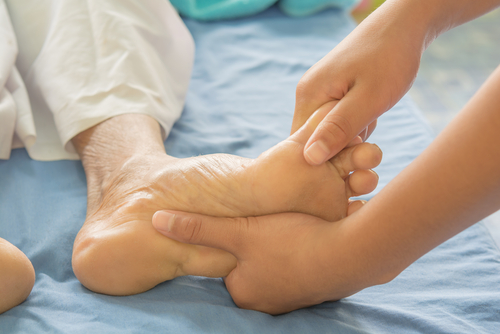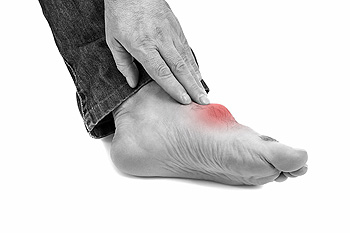How Toenail Fungus Is Contagious
 Fungal infections may occur in the toenails following exposure to a fungus, and it can be quite contagious. This often happens from walking barefoot in warm and moist environments that fungi thrive in, such as public swimming pools and locker room floors. You can also contract toenail fungus from sharing personal items such as shoes, socks, and towels with a person who has a fungal infection. Toenail fungus can also be spread from the nails to other areas of your body. This condition may spread from the infected nail to your other toenails, the skin between your toes, your groin area, or scalp. If you have toenail fungus, it is suggested that you seek treatment from a podiatrist.
Fungal infections may occur in the toenails following exposure to a fungus, and it can be quite contagious. This often happens from walking barefoot in warm and moist environments that fungi thrive in, such as public swimming pools and locker room floors. You can also contract toenail fungus from sharing personal items such as shoes, socks, and towels with a person who has a fungal infection. Toenail fungus can also be spread from the nails to other areas of your body. This condition may spread from the infected nail to your other toenails, the skin between your toes, your groin area, or scalp. If you have toenail fungus, it is suggested that you seek treatment from a podiatrist.
For more information about treatment, contact Dr. Joshua David Scoll of Pennsylvania. Our doctor can provide the care you need to keep you pain-free and on your feet.
Toenail Fungus Treatment
Toenail fungus is a condition that affects many people and can be especially hard to get rid of. Fortunately, there are several methods to go about treating and avoiding it.
Antifungals & Deterrence
Oral antifungal medicine has been shown to be effective in many cases. It is important to consult with a podiatrist to determine the proper regiment for you, or potentially explore other options.
Applying foot powder on the feet and shoes helps keep the feet free of moisture and sweat.
Sandals or open toed shoes – Wearing these will allow air movement and help keep feet dry. They also expose your feet to light, which fungus cannot tolerate. Socks with moisture wicking material also help as well.
If you have any questions please feel free to contact one of our offices located in Philadelphia, Bensalem, and Fairless Hills, PA . We offer the newest diagnostic tools and technology to treat your foot and ankle needs.
Yoga for Plantar Fasciitis Pain
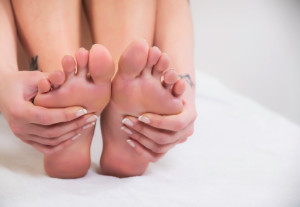 Plantar fasciitis is a condition in which the plantar fascia, a ligament that runs along the bottom of the foot, becomes inflamed. This can cause a stabbing pain in the heel. Stretching the foot may help reduce the pain associated with plantar fasciitis. Did you know that you can stretch the feet while doing yoga? For example, while standing, lift your right heel off of the ground and roll onto your right toes. Then place your right heel back onto the ground and repeat on the opposite foot. Do this several times to stretch the arch area. For more information about the benefits of yoga and stretching for plantar fasciitis pain, please consult with a podiatrist.
Plantar fasciitis is a condition in which the plantar fascia, a ligament that runs along the bottom of the foot, becomes inflamed. This can cause a stabbing pain in the heel. Stretching the foot may help reduce the pain associated with plantar fasciitis. Did you know that you can stretch the feet while doing yoga? For example, while standing, lift your right heel off of the ground and roll onto your right toes. Then place your right heel back onto the ground and repeat on the opposite foot. Do this several times to stretch the arch area. For more information about the benefits of yoga and stretching for plantar fasciitis pain, please consult with a podiatrist.
Plantar fasciitis can be very painful and inconvenient. If you are experiencing heel pain or symptoms of plantar fasciitis, contact Dr. Joshua David Scoll from Pennsylvania. Our doctor can provide the care you need to keep you pain-free and on your feet.
What Is Plantar Fasciitis?
Plantar fasciitis is the inflammation of the thick band of tissue that runs along the bottom of your foot, known as the plantar fascia, and causes mild to severe heel pain.
What Causes Plantar Fasciitis?
- Excessive running
- Non-supportive shoes
- Overpronation
- Repeated stretching and tearing of the plantar fascia
How Can It Be Treated?
- Conservative measures – anti-inflammatories, ice packs, stretching exercises, physical therapy, orthotic devices
- Shockwave therapy – sound waves are sent to the affected area to facilitate healing and are usually used for chronic cases of plantar fasciitis
- Surgery – usually only used as a last resort when all else fails. The plantar fascia can be surgically detached from the heel
While very treatable, plantar fasciitis is definitely not something that should be ignored. Especially in severe cases, speaking to your doctor right away is highly recommended to avoid complications and severe heel pain. Your podiatrist can work with you to provide the appropriate treatment options tailored to your condition.
If you have any questions please feel free to contact one of our offices located in Philadelphia, Bensalem, and Fairless Hills, PA . We offer the newest diagnostic and treatment technologies for all your foot and ankle needs.
Foot and Ankle Issues That Are Common in Baseball
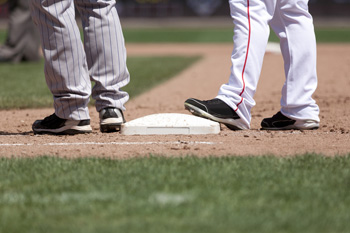 Because there are a variety of risks that come from playing baseball, and the feet and ankles take a beating, it is important to be mindful of the variety of foot and ankle injuries that can occur while playing baseball. Ankle sprains, which occur as damage to the ligaments in the ankle, are common and should be evaluated by a podiatrist to check for further damage. Overuse and excessive training can lead to injuries such as Achilles tendinopathy or plantar fasciitis, which is indicated by heel pain. Ingrown toenails, which are indicated by redness around the affected nail, are also common amongst baseball players, and if left untreated, may become infected. Cleats that do not fit correctly can also irritate issues such as neuromas, bunions and hammertoes, so it is important to make sure your cleats fit properly. If you believe that you have injured your foot or ankle from playing baseball or any sport, it is important to consult with a podiatrist for a proper diagnosis and treatment.
Because there are a variety of risks that come from playing baseball, and the feet and ankles take a beating, it is important to be mindful of the variety of foot and ankle injuries that can occur while playing baseball. Ankle sprains, which occur as damage to the ligaments in the ankle, are common and should be evaluated by a podiatrist to check for further damage. Overuse and excessive training can lead to injuries such as Achilles tendinopathy or plantar fasciitis, which is indicated by heel pain. Ingrown toenails, which are indicated by redness around the affected nail, are also common amongst baseball players, and if left untreated, may become infected. Cleats that do not fit correctly can also irritate issues such as neuromas, bunions and hammertoes, so it is important to make sure your cleats fit properly. If you believe that you have injured your foot or ankle from playing baseball or any sport, it is important to consult with a podiatrist for a proper diagnosis and treatment.
Ankle and foot injuries are common among athletes and in many sports. They can be caused by several problems and may be potentially serious. If you are feeling pain or think you were injured in a sporting event or when exercising, consult with Dr. Joshua David Scoll from Pennsylvania. Our doctor will assess your condition and provide you with quality foot and ankle treatment.
Common Injuries
The most common injuries that occur in sporting activities include:
- Achilles Tendonitis
- Achilles Tendon Rupture
- Ankle Sprains
- Broken Foot
- Plantar Fasciitis
- Stress Fractures
- Turf Toe
Symptoms
Symptoms vary depending upon the injury and in some cases, there may be no symptoms at all. However, in most cases, some form of symptom is experienced. Pain, aching, burning, bruising, tenderness, tightness or stiffness, sensation loss, difficulty moving, and swelling are the most common symptoms.
Treatment
Just as symptoms vary depending upon the injury, so do treatment options. A common treatment method is known as the RICE method. This method involves rest, applying ice, compression and elevating the afflicted foot or ankle. If the injury appears to be more serious, surgery might be required, such as arthroscopic or reconstructive surgery. Lastly, rehabilitation or therapy might be needed to gain full functionality in the afflicted area. Any discomfort experienced by an athlete must be evaluated by a licensed, reputable medical professional.
If you have any questions, please feel free to contact one of our offices located in Philadelphia, Bensalem, and Fairless Hills, PA . We offer the newest diagnostic and treatment technologies for all your foot care needs.
What Are Common Symptoms of a Sprained Ankle?
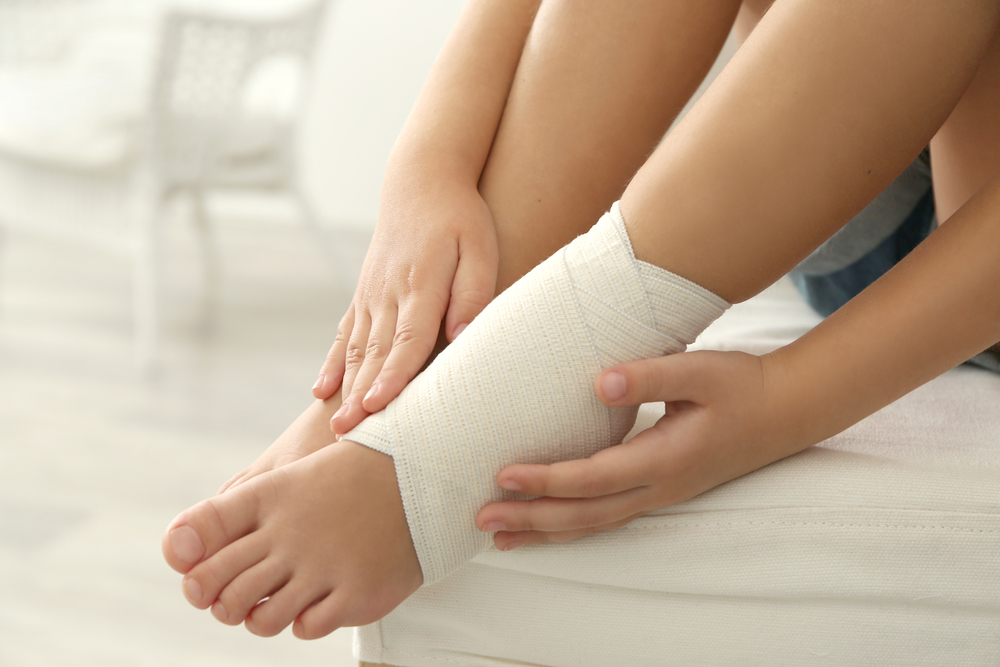 Torn ligaments in the ankle may be indicative of an ankle sprain. This can occur by suddenly stepping off of a curb, or from twisting the ankle beyond its normal limitations. Common symptoms that are often associated with this ailment can include immediate swelling, bruising, and it can become difficult to walk. Patients may find it painful to move the affected area, and the overall ankle may hurt when it is touched. It is beneficial to seek immediate medical attention if you feel you have sprained your ankle. A visit for a sprained ankle generally consists of having an X-ray taken, which is helpful in ruling out a broken ankle. Mild relief may be found when the affected foot is elevated, in addition to wrapping it with an elastic bandage. This is needed to provide ankle stability as the healing process takes place. If you think that you may have sprained your ankle, it is strongly suggested that you seek the counsel of a podiatrist who can effectively treat this condition.
Torn ligaments in the ankle may be indicative of an ankle sprain. This can occur by suddenly stepping off of a curb, or from twisting the ankle beyond its normal limitations. Common symptoms that are often associated with this ailment can include immediate swelling, bruising, and it can become difficult to walk. Patients may find it painful to move the affected area, and the overall ankle may hurt when it is touched. It is beneficial to seek immediate medical attention if you feel you have sprained your ankle. A visit for a sprained ankle generally consists of having an X-ray taken, which is helpful in ruling out a broken ankle. Mild relief may be found when the affected foot is elevated, in addition to wrapping it with an elastic bandage. This is needed to provide ankle stability as the healing process takes place. If you think that you may have sprained your ankle, it is strongly suggested that you seek the counsel of a podiatrist who can effectively treat this condition.
Ankle sprains are common but need immediate attention. If you need your feet checked, contact Dr. Joshua David Scoll from Pennsylvania. Our doctor can provide the care you need to keep you pain-free and on your feet.
How Does an Ankle Sprain Occur?
Ankle sprains take place when the ligaments in your ankle are torn or stretched beyond their limits. There are multiple ways that the ankle can become injured, including twisting or rolling over onto your ankle, putting undue stress on it, or causing trauma to the ankle itself.
What Are the Symptoms?
- Mild to moderate bruising
- Limited mobility
- Swelling
- Discoloration of the skin (depending on severity)
Preventing a Sprain
- Wearing appropriate shoes for the occasion
- Stretching before exercises and sports
- Knowing your limits
Treatment of a Sprain
Treatment of a sprain depends on the severity. Many times, people are told to rest and remain off their feet completely, while others are given an air cast. If the sprain is very severe, surgery may be required.
If you have suffered an ankle sprain previously, you may want to consider additional support such as a brace and regular exercises to strengthen the ankle.
If you have any questions please feel free to contact one of our offices located in Philadelphia, Bensalem, and Fairless Hills, PA . We offer the newest diagnostic and treatment technologies for all your foot and ankle needs.
Foot Conditions That May Benefit From Orthotics
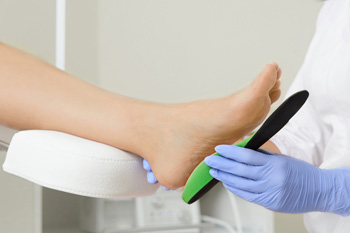 Living with daily foot pain can disrupt the quality of your life. It may cause difficulty completing daily activities. Simple things like walking and standing may become overwhelming. Many patients who are afflicted with foot pain are prescribed orthotics. Orthotics are custom made inserts that fit inside of the shoe. They are known to relieve pressure by redistributing the body’s weight, and may help in making everyday tasks more manageable. Some of the ailments orthotics can be used for include bunions, rheumatoid arthritis, and heel or arch pain, which may be caused by plantar fasciitis. If you have any type of foot pain, it is strongly recommended that you consult with a podiatrist who can determine if orthotics are right for you.
Living with daily foot pain can disrupt the quality of your life. It may cause difficulty completing daily activities. Simple things like walking and standing may become overwhelming. Many patients who are afflicted with foot pain are prescribed orthotics. Orthotics are custom made inserts that fit inside of the shoe. They are known to relieve pressure by redistributing the body’s weight, and may help in making everyday tasks more manageable. Some of the ailments orthotics can be used for include bunions, rheumatoid arthritis, and heel or arch pain, which may be caused by plantar fasciitis. If you have any type of foot pain, it is strongly recommended that you consult with a podiatrist who can determine if orthotics are right for you.
If you are having discomfort in your feet and would like to try orthotics, contact Dr. Joshua David Scoll from Pennsylvania. Our doctor can provide the care you need to keep you pain-free and on your feet.
What Are Orthotics?
Orthotics are inserts you can place into your shoes to help with a variety of foot problems such as flat feet or foot pain. Orthotics provide relief and comfort for minor foot and heel pain but can’t correct serious biomechanical problems in your feet.
Over-the-Counter Inserts
Orthotics come in a wide variety of over-the-counter inserts that are used to treat foot pain, heel pain, and minor problems. For example, arch supports can be inserted into your shoes to help correct overarched or flat feet, while gel insoles are often used because they provide comfort and relief from foot and heel pain by alleviating pressure.
Prescription Orthotics
If over-the-counter inserts don’t work for you or if you have a more severe foot concern, it is possible to have your podiatrist prescribe custom orthotics. These high-quality inserts are designed to treat problems such as abnormal motion, plantar fasciitis, and severe forms of heel pain. They can even be used to help patients suffering from diabetes by treating foot ulcers and painful calluses and are usually molded to your feet individually, which allows them to provide full support and comfort.
If you are experiencing minor to severe foot or heel pain, it’s recommended to speak with your podiatrist about the possibilities of using orthotics. A podiatrist can determine which type of orthotic is right for you and allow you to take the first steps towards being pain-free.
If you have any questions please contact one of our offices located in Philadelphia, Bensalem, and Fairless Hills, PA . We offer the newest diagnostic and treatment technologies for all your foot and ankle needs.
A Common Type of Arthritis That Affects the Feet
 Patients who are afflicted with arthritis are often aware of the pain and discomfort that is felt in the joints of the feet. There are several different types of arthritis. Psoriatic arthritis generally affects patients who have the medical condition that is known as psoriasis and can target the cartilage in the feet. The inflamed joints can make it difficult to accomplish daily activities, and the feet may appear swollen. This ailment may lead to the onset of additional foot conditions, and there may be noticeable differences in the nail bed. If you have stiffness and joint pain in your feet, it is strongly recommended that you consult with a podiatrist who can offer the right treatment options for you.
Patients who are afflicted with arthritis are often aware of the pain and discomfort that is felt in the joints of the feet. There are several different types of arthritis. Psoriatic arthritis generally affects patients who have the medical condition that is known as psoriasis and can target the cartilage in the feet. The inflamed joints can make it difficult to accomplish daily activities, and the feet may appear swollen. This ailment may lead to the onset of additional foot conditions, and there may be noticeable differences in the nail bed. If you have stiffness and joint pain in your feet, it is strongly recommended that you consult with a podiatrist who can offer the right treatment options for you.
Arthritis can be a difficult condition to live with. If you are seeking treatment, contact Dr. Joshua David Scoll from Pennsylvania. Our doctor can provide the care you need to keep you pain-free and on your feet.
Arthritic Foot Care
Arthritis is a joint disorder that involves the inflammation of different joints in your body, such as those in your feet. Arthritis is often caused by a degenerative joint disease and causes mild to severe pain in all affected areas. In addition to this, swelling and stiffness in the affected joints can also be a common symptom of arthritis.
In many cases, wearing ill-fitting shoes can worsen the effects and pain of arthritis. Wearing shoes that have a lower heel and extra room can help your feet feel more comfortable. In cases of rheumatoid arthritis, the arch in your foot may become problematic. Buying shoes with proper arch support that contour to your feet can help immensely.
Alleviating Arthritic Pain
- Exercises that stretch the foot can prevent further pain and injury and increase mobility
- Most of the pain can be alleviated with anti-inflammatory drugs, heat, and topical medications
- Massages can help temporarily alleviate pain.
It is best to see your doctor for the treatment that is right for your needs and symptoms. Conditions vary, and a podiatrist can help you determine the right method of care for your feet.
If you have any questions, please feel free to contact one of our offices located in Philadelphia, Bensalem, and Fairless Hills, PA . We offer the newest diagnostic tools and technology to treat your foot and ankle needs.
Children's Shoes Should Be the Right Size
 Getting your child shoes that fit properly is crucial to having their feet feel comfortable during everyday activities. The ideal shoes for your child to wear should be constructed with soft, breathable, and flexible materials. Children’s feet grow approximately a half inch per year, so it is important to ensure that your child’s shoes fit properly. It is beneficial to measure your child’s feet every month, as this will help you choose the right size shoes. Most children are unable to tie their shoes at this early age, and it is suggested that Velcro straps are used. If you would like additional information about how to purchase the correct size children’s shoes, please confer with a podiatrist.
Getting your child shoes that fit properly is crucial to having their feet feel comfortable during everyday activities. The ideal shoes for your child to wear should be constructed with soft, breathable, and flexible materials. Children’s feet grow approximately a half inch per year, so it is important to ensure that your child’s shoes fit properly. It is beneficial to measure your child’s feet every month, as this will help you choose the right size shoes. Most children are unable to tie their shoes at this early age, and it is suggested that Velcro straps are used. If you would like additional information about how to purchase the correct size children’s shoes, please confer with a podiatrist.
The health of a child’s feet is vital to their overall well-being. If you have any questions regarding foot health, contact Dr. Joshua David Scoll of Pennsylvania. Our doctor can provide the care you need to keep you pain-free and on your feet.
Tips for Keeping Children's Feet Healthy
- Make sure their shoes fit properly
- Look for any signs of in-toeing or out-toeing
- Check to see if they have Clubfoot (condition that affects your child’s foot and ankle, twisting the heel and toes inward) which is one of the most common nonmajor birth defects.
- Lightly cover your baby’s feet (Tight covers may keep your baby from moving their feet freely, and could prevent normal development)
- Allow your toddler to go shoeless (Shoes can be restricting for a young child’s foot)
- Cut toenails straight across to avoid ingrown toenails
- Keep your child’s foot clean and dry
- Cover cuts and scrapes. Wash any scratches with soap and water and cover them with a bandage until they’ve healed.
If you have any questions, please feel free to contact one of our offices located in Philadelphia, Bensalem, and Fairless Hills, PA . We offer the newest diagnostic and treatment technologies for all your foot care needs.
What Can Cause Sever’s Disease?
 Irritation of the growth plate on the heel can occur in young and teenaged children from participating in running and jumping activities. This is a condition that is referred to as Sever’s disease, and it can cause severe pain and discomfort. Childhood and adolescence is a time of life when the bones in the leg can grow faster than the muscles and tendons, possibly causing heel conditions. Some of the symptoms that can be associated with Sever’s disease include heel pain after arising in the morning and difficulty walking and running. It is suggested that your child stop the activity that may have caused this condition, and mild relief may be found when specific stretches are performed. If you notice that your child is limping or complaining of heel pain, it is strongly suggested that you schedule a consultation with a podiatrist who can properly diagnose and treat Sever’s disease.
Irritation of the growth plate on the heel can occur in young and teenaged children from participating in running and jumping activities. This is a condition that is referred to as Sever’s disease, and it can cause severe pain and discomfort. Childhood and adolescence is a time of life when the bones in the leg can grow faster than the muscles and tendons, possibly causing heel conditions. Some of the symptoms that can be associated with Sever’s disease include heel pain after arising in the morning and difficulty walking and running. It is suggested that your child stop the activity that may have caused this condition, and mild relief may be found when specific stretches are performed. If you notice that your child is limping or complaining of heel pain, it is strongly suggested that you schedule a consultation with a podiatrist who can properly diagnose and treat Sever’s disease.
Sever's disease often occurs in children and teens. If your child is experiencing foot or ankle pain, see Dr. Joshua David Scoll from Pennsylvania. Our doctor can treat your child’s foot and ankle needs.
Sever’s Disease
Sever’s disease is also known as calcaneal apophysitis, which is a medical condition that causes heel pain I none or both feet. The disease is known to affect children between the ages of 8 and 14.
Sever’s disease occurs when part of the child’s heel known as the growth plate (calcaneal epiphysis) is attached to the Achilles tendon. This area can suffer injury when the muscles and tendons of the growing foot do not keep pace with bone growth. Therefore, the constant pain which one experiences at the back of the heel will make the child unable to put any weight on the heel. The child is then forced to walk on their toes.
Symptoms
Acute pain – Pain associated with Sever’s disease is usually felt in the heel when the child engages in physical activity such as walking, jumping and or running.
Highly active – Children who are very active are among the most susceptible in experiencing Sever’s disease, because of the stress and tension placed on their feet.
If you have any questions, please feel free to contact one of our offices located in Philadelphia, Bensalem, and Fairless Hills, PA . We offer the newest diagnostic and treatment technologies for all your foot and ankle injuries.
A Massage for Arch Pain
Foot massages can be relaxing, but did you know that they can also benefit your foot health? A foot massage can help stretch and relax the feet, leading to less foot pain. If you experience pain or tension in the arch of your foot, you may want to try an arch massage. This is done by holding the top of the foot in one hand and rubbing the length of the arch with the fingers of the other hand. Repeat this several times on each foot, going from the heel to the arch. For more information about the benefits of foot massage, consult with a podiatrist today.
Foot therapy is often necessary for those recovering from either foot deformities or foot injuries. If you have concerns regarding therapy, consult with Dr. Joshua David Scoll from Pennsylvania. Our doctor can provide the care you need to keep you pain-free and on your feet.
Most Common Injuries
People who are active or athletes are prone to a variety of injuries. Therefore, it is often important to take part in physical therapy in order to quickly get back on the right track.
What to Do When Injured
Physical Therapy – This specialized treatment will focus on the affected area, speeding up recovery and the overall healing process. It is a proven method that has helped millions of people return from any injury.
During physical therapy you will undergo regimented training to get back into full form. Training is often very difficult, especially at first when the foot feels weak. Physical therapy often involves:
Basic stretching and twisting exercises – getting the feet’s mobility and flexibility up.
Massaging – the therapist will massage the injured area in order to activate the muscles and relax them.
Strengthening Exercises – this allows the muscles in the affected area to regain their full strength, a vital step towards full recovery.
If you have any questions please feel free to contact one of our offices located in Philadelphia, Bensalem, and Fairless Hills, PA . We offer the newest diagnostic tools and technology to treat your foot and ankle needs.
Stretches May Help Heel Spurs
 A small growth in the heel bone is often referred to as a heel spur. These are bony protrusions that may cause severe pain and discomfort, and can be associated with foot conditions such as plantar fasciitis and Achilles tendon injuries. Some patients find it beneficial to perform specific stretches and exercises that may diminish a portion of the discomfort. An effective stretch consists of raising up on the toes while placing a tennis ball between the ankles, and gently squeezing. Additionally, it may help to roll a tennis ball on the sole of the foot while seated. Mild relief may be found when correct shoes are worn, and it is suggested to refrain from wearing high heels or flip flops. If you have heel pain, it is suggested that you consult with a podiatrist who can properly diagnose and treat heel spurs.
A small growth in the heel bone is often referred to as a heel spur. These are bony protrusions that may cause severe pain and discomfort, and can be associated with foot conditions such as plantar fasciitis and Achilles tendon injuries. Some patients find it beneficial to perform specific stretches and exercises that may diminish a portion of the discomfort. An effective stretch consists of raising up on the toes while placing a tennis ball between the ankles, and gently squeezing. Additionally, it may help to roll a tennis ball on the sole of the foot while seated. Mild relief may be found when correct shoes are worn, and it is suggested to refrain from wearing high heels or flip flops. If you have heel pain, it is suggested that you consult with a podiatrist who can properly diagnose and treat heel spurs.
Heel spurs can be incredibly painful and sometimes may make you unable to participate in physical activities. To get medical care for your heel spurs, contact Dr. Joshua David Scoll from Pennsylvania. Our doctor will do everything possible to treat your condition.
Heels Spurs
Heel spurs are formed by calcium deposits on the back of the foot where the heel is. This can also be caused by small fragments of bone breaking off one section of the foot, attaching onto the back of the foot. Heel spurs can also be bone growth on the back of the foot and may grow in the direction of the arch of the foot.
Older individuals usually suffer from heel spurs and pain sometimes intensifies with age. One of the main condition's spurs are related to is plantar fasciitis.
Pain
The pain associated with spurs is often because of weight placed on the feet. When someone is walking, their entire weight is concentrated on the feet. Bone spurs then have the tendency to affect other bones and tissues around the foot. As the pain continues, the feet will become tender and sensitive over time.
Treatments
There are many ways to treat heel spurs. If one is suffering from heel spurs in conjunction with pain, there are several methods for healing. Medication, surgery, and herbal care are some options.
If you have any questions feel free to contact one of our offices located in Philadelphia, Bensalem, and Fairless Hills, PA . We offer the latest in diagnostic and treatment technology to meet your needs.
Preventing Blisters for Runners
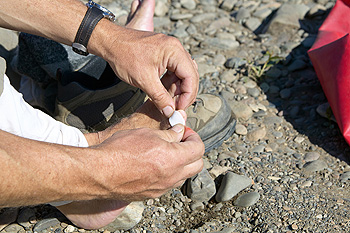 If you are a runner, then you are likely not a stranger to blisters. Most blisters are caused by the repetitive friction of your shoes rubbing against the skin of your foot. Blisters can be painful and may make it difficult to continue running. Fortunately, there are multiple things that you can do to prevent blisters. Make sure that you run in properly fitted, supportive running shoes and socks that are made specifically for running. If there are areas of your feet that are prone to developing blisters while you run, you can place moleskin bandage, pads, or athletic tape over them. If you have calluses on your feet, you may want to keep them, as they can actually protect your feet from blistering while you run. For more information about preventing blisters and other foot and ankle injuries, consult with a podiatrist today.
If you are a runner, then you are likely not a stranger to blisters. Most blisters are caused by the repetitive friction of your shoes rubbing against the skin of your foot. Blisters can be painful and may make it difficult to continue running. Fortunately, there are multiple things that you can do to prevent blisters. Make sure that you run in properly fitted, supportive running shoes and socks that are made specifically for running. If there are areas of your feet that are prone to developing blisters while you run, you can place moleskin bandage, pads, or athletic tape over them. If you have calluses on your feet, you may want to keep them, as they can actually protect your feet from blistering while you run. For more information about preventing blisters and other foot and ankle injuries, consult with a podiatrist today.
Blisters are prone to making everyday activities extremely uncomfortable. If your feet are hurting, contact Dr. Joshua David Scoll of Pennsylvania. Our doctor can provide the care you need to keep you pain-free and on your feet.
Foot Blisters
Foot blisters develop as a result of constantly wearing tight or ill-fitting footwear. This happens due to the constant rubbing from the shoe, which can often lead to pain.
What Are Foot Blisters?
A foot blister is a small fluid-filled pocket that forms on the upper-most layer of the skin. Blisters are filled with clear fluid and can lead to blood drainage or pus if the area becomes infected.
How Do Blisters Form?
Blisters on the feet are often the result of constant friction of skin and material, usually by shoe rubbing. Walking in sandals, boots, or shoes that don’t fit properly for long periods of time can result in a blister. Having consistent foot moisture and humidity can easily lead to blister formation.
Prevention & Treatment
It is important to properly care for the affected area in order to prevent infection and ease the pain. Do not lance the blister and use a Band-Aid to provide pain relief. Also, be sure to keep your feet dry and wear proper fitting shoes. If you see blood or pus in a blister, seek assistance from a podiatrist.
If you have any questions, please feel free to contact one of our offices located in Philadelphia, Bensalem, and Fairless Hills, PA . We offer the newest diagnostic and treatment technologies for all your foot care needs.
What Can I Do to Manage My Gout?
If you have ever experienced a gout attack, then you are familiar with the sudden pain and swelling that this condition can cause in the joints of the feet. Fortunately, there are several ways to manage gout. Your doctor may prescribe specific medications or injections to minimize the joint pain, swelling, and inflammation caused by gout. Lifestyle factors can also play a role in managing this condition. Avoiding foods that are high in purines, such as organ meats and seafood, and staying well-hydrated by drinking plenty of water can help reduce the frequency of attacks. Immobilizing and elevating the affected foot may also help you find relief, as resting your foot can decrease swelling. For more information on how to best manage gout, consult with a podiatrist today.
Gout is a foot condition that requires certain treatment and care. If you are seeking treatment, contact Dr. Joshua David Scoll from Pennsylvania. Our doctor will treat your foot and ankle needs.
What Is Gout?
Gout is a type of arthritis caused by a buildup of uric acid in the bloodstream. It often develops in the foot, especially the big toe area, although it can manifest in other parts of the body as well. Gout can make walking and standing very painful and is especially common in diabetics and the obese.
People typically get gout because of a poor diet. Genetic predisposition is also a factor. The children of parents who have had gout frequently have a chance of developing it themselves.
Gout can easily be identified by redness and inflammation of the big toe and the surrounding areas of the foot. Other symptoms include extreme fatigue, joint pain, and running high fevers. Sometimes corticosteroid drugs can be prescribed to treat gout, but the best way to combat this disease is to get more exercise and eat a better diet.
If you have any questions please feel free to contact one of our offices located in Philadelphia, Bensalem, and Fairless Hills, PA . We offer the newest diagnostic and treatment technologies for all your foot and ankle needs.
More...
Effects of Trauma to the Feet
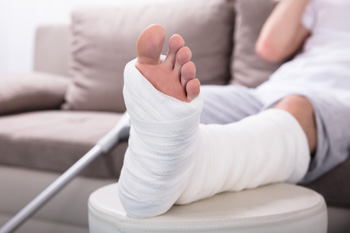 There are many factors that can go into why a person’s feet may be experiencing pain, one of which is trauma. When trauma or injury occurs to the foot, various complications may develop. The injured foot may begin to swell, feel tender, bruise, and become difficult to walk on. Trauma may also cause the foot, toes, and lower extremity regions to sprain or break. In order to properly treat trauma to the foot, it’s important that you get examined by a podiatrist who can give you a professional diagnosis, and determine the best treatment option to relieve your pain. If you have experienced trauma or injury to your foot, please consult with a podiatrist as soon as possible for prompt treatment.
There are many factors that can go into why a person’s feet may be experiencing pain, one of which is trauma. When trauma or injury occurs to the foot, various complications may develop. The injured foot may begin to swell, feel tender, bruise, and become difficult to walk on. Trauma may also cause the foot, toes, and lower extremity regions to sprain or break. In order to properly treat trauma to the foot, it’s important that you get examined by a podiatrist who can give you a professional diagnosis, and determine the best treatment option to relieve your pain. If you have experienced trauma or injury to your foot, please consult with a podiatrist as soon as possible for prompt treatment.
Foot and ankle trauma is common among athletes and the elderly. If you have concerns that you may have experienced trauma to the foot and ankle, consult with Dr. Joshua David Scoll from Pennsylvania. Our doctor will assess your condition and provide you with quality foot and ankle treatment.
Foot and ankle trauma cover a range of injuries all over the foot; common injuries include:
- Broken bones
- Muscle strains
- Injuries to the tendons and ligaments
- Stress fractures
Symptoms
Symptoms of foot and ankle injuries vary depending on the injury, but more common ones include:
- Bruising
- Inflammation/ Swelling
- Pain
Diagnosis
To properly diagnose the exact type of injury, podiatrists will conduct a number of different tests. Some of these include sensation and visual tests, X-rays, and MRIs. Medical and family histories will also be taken into account.
Treatment
Once the injury has been diagnosed, the podiatrist can than offer the best treatment options for you. In less severe cases, rest and keeping pressure off the foot may be all that’s necessary. Orthotics, such as a specially made shoes, or immobilization devices, like splints or casts, may be deemed necessary. Finally, if the injury is severe enough, surgery may be necessary.
If you have any questions, please feel free to contact one of our offices located in Philadelphia, Bensalem, and Fairless Hills, PA . We offer the newest diagnostic and treatment technologies for all your foot care needs.
What Kind of Shoe Should I Work Out In?
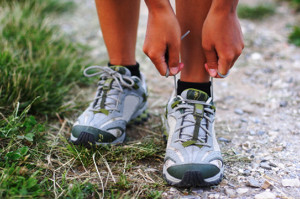 When it comes to working out, one of the most important accessories you can have is a pair of workout shoes designed for the type of exercise you like to practice. For example, if you’re going to be practicing weight lifting, you’re not going to want to wear thick-soled running shoes. Weight-lifting is best practiced with flat-soled shoes as they help with keeping proper form, and provide a firm grip on the ground. Cardio and strength training require a different style of shoe. Because you’ll be constantly moving and jumping around, you’ll want a shoe with extra cushion and support, as well as a wide toe. For professional advice on which shoes you should be wearing while working out, please speak with a podiatrist.
When it comes to working out, one of the most important accessories you can have is a pair of workout shoes designed for the type of exercise you like to practice. For example, if you’re going to be practicing weight lifting, you’re not going to want to wear thick-soled running shoes. Weight-lifting is best practiced with flat-soled shoes as they help with keeping proper form, and provide a firm grip on the ground. Cardio and strength training require a different style of shoe. Because you’ll be constantly moving and jumping around, you’ll want a shoe with extra cushion and support, as well as a wide toe. For professional advice on which shoes you should be wearing while working out, please speak with a podiatrist.
Finding a properly-fitting shoe is important in reducing injuries and preventing foot problems. For more information about treatment, contact Dr. Joshua David Scoll from Pennsylvania. Our doctor will treat your foot and ankle needs.
Proper Shoe Fitting
A common concern when it comes to foot health, having properly fitted shoes can help prevent injuries to the foot. Out feet affect our posture and gait, which in turn affects the biomechanics and overall bodily structure. With 33 joints, 26 bones, and over 100 ligaments, the potential for serious injury is much greater than one realizes. Although the feet cease growth in adulthood, they still change shape as they mature. Here are some factors to consider when it comes to investing in proper fitting shoes:
- Be sure the shoes fit correctly right away
- Ensure the ball of your foot fits comfortably in the widest portion of the shoes
- Even though they may look fashionable, improper fitting shoes can either create adverse conditions or exacerbate existing ones you may already have
- Walk along a carpeted surface to ensure the shoes comfortably fit during normal activity
Keeping in mind how shoes fit the biomechanics of your body, properly-fitting shoes are vitally important. Fortunately, it is not difficult to acquire footwear that fits correctly. Be sure to wear shoes that support the overall structure of your body. Do your feet a favor and invest in several pairs of well-fitted shoes today.
If you have any questions please feel free to contact one of our offices located in Philadelphia, Bensalem, and Fairless Hills, PA . We offer the newest diagnostic and treatment technologies for all your foot and ankle needs.
Treatments for Diabetic Foot Ulcers
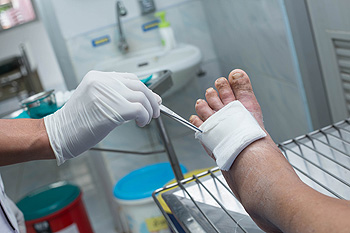 Diabetic foot ulcers are open wounds that typically form on the bottom of the feet in people with diabetes. These wounds generally heal slowly and are prone to infection. They also tend to recur even after they have healed. There are various treatments available for diabetic foot ulcers, including removing or minimizing weight placed on the foot, called offloading, and taking antibiotics for infections. Sometimes, removing dead tissue around the ulcer, a process called debridement, may be necessary. Utilizing a patient-centered approach is necessary for selecting appropriate treatments and achieving best possible outcomes. For more information about treatments for diabetic foot ulcers, consult with a podiatrist today.
Diabetic foot ulcers are open wounds that typically form on the bottom of the feet in people with diabetes. These wounds generally heal slowly and are prone to infection. They also tend to recur even after they have healed. There are various treatments available for diabetic foot ulcers, including removing or minimizing weight placed on the foot, called offloading, and taking antibiotics for infections. Sometimes, removing dead tissue around the ulcer, a process called debridement, may be necessary. Utilizing a patient-centered approach is necessary for selecting appropriate treatments and achieving best possible outcomes. For more information about treatments for diabetic foot ulcers, consult with a podiatrist today.
Wound care is an important part in dealing with diabetes. If you have diabetes and a foot wound or would like more information about wound care for diabetics, consult with Dr. Joshua David Scoll from Pennsylvania. Our doctor will assess your condition and provide you with quality foot and ankle treatment.
What Is Wound Care?
Wound care is the practice of taking proper care of a wound. This can range from the smallest to the largest of wounds. While everyone can benefit from proper wound care, it is much more important for diabetics. Diabetics often suffer from poor blood circulation which causes wounds to heal much slower than they would in a non-diabetic.
What Is the Importance of Wound Care?
While it may not seem apparent with small ulcers on the foot, for diabetics, any size ulcer can become infected. Diabetics often also suffer from neuropathy, or nerve loss. This means they might not even feel when they have an ulcer on their foot. If the wound becomes severely infected, amputation may be necessary. Therefore, it is of the upmost importance to properly care for any and all foot wounds.
How to Care for Wounds
The best way to care for foot wounds is to prevent them. For diabetics, this means daily inspections of the feet for any signs of abnormalities or ulcers. It is also recommended to see a podiatrist several times a year for a foot inspection. If you do have an ulcer, run the wound under water to clear dirt from the wound; then apply antibiotic ointment to the wound and cover with a bandage. Bandages should be changed daily and keeping pressure off the wound is smart. It is advised to see a podiatrist, who can keep an eye on it.
If you have any questions, please feel free to contact one of our offices located in Philadelphia, Bensalem, and Fairless Hills, PA . We offer the newest diagnostic and treatment technologies for all your foot care needs.
What Is Total Ankle Replacement Surgery?
 Total ankle replacement surgery, also known as total ankle arthroplasty, is a procedure designed to reduce ankle pain. In this procedure, the surgeon removes the bottom portion of the shin bone and the top portion of the foot bone, replacing the ankle with plastic or metal pieces. This type of surgery is done in cases of severe pain and loss of motion in the ankle, which may be caused by arthritis. Total ankle replacement surgery is often a last resort, only performed when more conservative treatments have not led to any improvement. It typically takes at least four months to recover from this procedure, and follow-up care is very important to ensure optimal results. If you are experiencing severe ankle pain, it is recommended that you see a podiatrist for treatment.
Total ankle replacement surgery, also known as total ankle arthroplasty, is a procedure designed to reduce ankle pain. In this procedure, the surgeon removes the bottom portion of the shin bone and the top portion of the foot bone, replacing the ankle with plastic or metal pieces. This type of surgery is done in cases of severe pain and loss of motion in the ankle, which may be caused by arthritis. Total ankle replacement surgery is often a last resort, only performed when more conservative treatments have not led to any improvement. It typically takes at least four months to recover from this procedure, and follow-up care is very important to ensure optimal results. If you are experiencing severe ankle pain, it is recommended that you see a podiatrist for treatment.
In certain cases, in which the patient suffers from extreme pain or damage in a joint, joint replacement surgery may be deemed useful. If you have constant pain in a foot joint, consult with Dr. Joshua David Scoll from Pennsylvania. Our doctor will assess your condition and provide you with quality foot and ankle treatment.
What Is Joint Replacement Surgery?
Over time, joints wear down; this can be exacerbated by diseases and conditions. Joint replacement surgery, also known as arthroplasty, is when a damaged joint is surgically removed and replaced with a prosthesis. Prostheses, which can be made of ceramic, plastic, or metal, act as joints in lieu of an actual joint. One of the most prevalent causes for joint replacement is arthritis.
Arthritis in the Foot
Arthritis can occur in any joint in the body, including in the feet. Common types of arthritis in the foot are osteoarthritis, rheumatoid arthritis, and gout. The big toe is usually where arthritis occurs in the foot; this is known as hallux rigidus.
Joint Replacement Surgery in the Foot
The most common form of joint replacement in the foot is a first metatarsophalangeal (MTP) joint placement. MTP joint replacement surgery is designed to treat hallux rigidus. Surgery is not intensive, and recovery occurs within one to two months after the procedure has been done. Overall, joint replacement surgery is a safe and effective way to treat pain in the joint of the foot.
If you have any questions, please feel free to contact one of our offices located in Philadelphia, Bensalem, and Fairless Hills, PA . We offer the newest diagnostic and treatment technologies for all your foot care needs.


